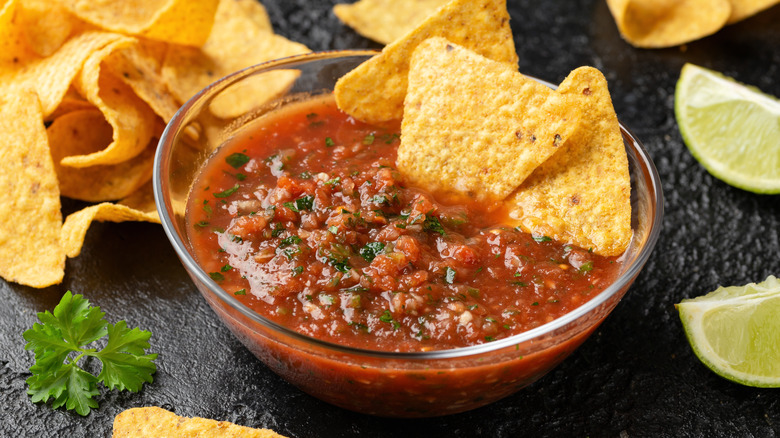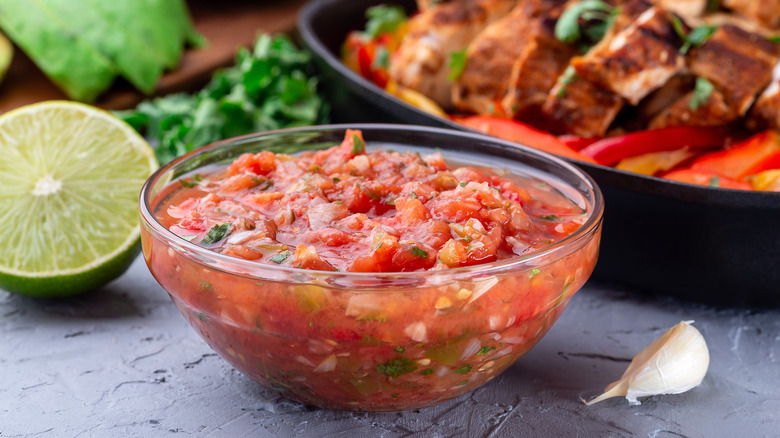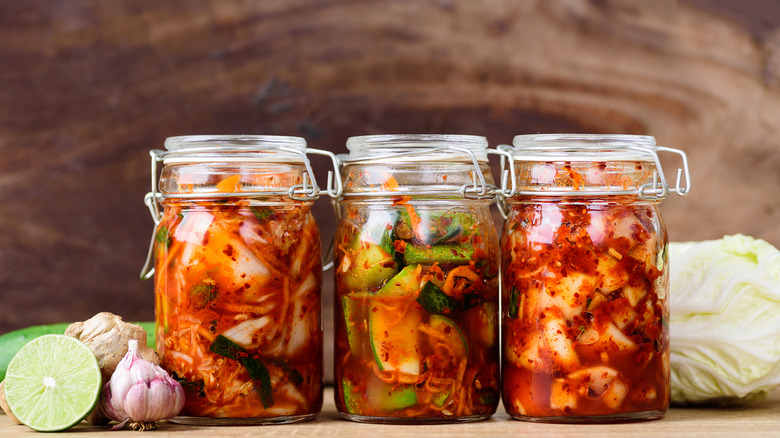Make Your Salsa Sparkle With A Fermented Fizz
A chef's secret weapon, fermented food products can make the difference between a pretty good dish and one forever seared in your memory. In Sandor Katz's "The Art of Fermentation," he defines fermentation as the process of transforming various foods by mobilizing the microorganisms that naturally exist in and around raw food products. As Katz notes, fermented products are not only inescapable in foods around the world, but "fermentation has played an instrumental role in human cultural evolution."
Alcohol might be the first thing that comes to mind when thinking about fermentation, but fermented ingredients and edible products can offer a level of unparalleled, funky deliciousness. We'll be the first to concede that a fresh salsa composed of veg plucked from your local farmer's market is glorious in all its freshness. But if you want to take humble salsa to the next level, fermentation might be your ticket to the effervescence you didn't know you were craving.
While you've perhaps never intentionally fermented anything (why does this expired orange juice taste so funky?), you've definitely encountered fermented products. From Korean gochujang to Germany's sauerkraut and England's Worcestershire sauce, you're possibly consuming things you didn't know were fermented. Bread, pickles, yogurt, crème fraîche, and kimchi all utilize fermentation. So, why not salsa?
Should you ferment salsa?
If you combine time, patience, and some food safety know-how, fermenting salsa is the perfect kitchen experiment for peak tomato season. Unlike some ambitious projects in the kitchen, most of the ingredients needed are the same as those required for your traditional salsa.
When chopping your salsa ingredients, be sure to err on the side of small rather than large pieces. Tomatoes, onion, chiles, cilantro, and garlic are notable participants, but use whatever sounds fun. Fruits like mangos, pineapples, and peaches can add an unsuspecting sweet note to balance out the salsa's salt, acid, and heat.
Salt is a vital part of this process that not only seasons but also prevents the growth of unwanted bacteria. Sandor Katz suggests salting 2% by weight, or 2 grams of salt for every 100 grams of veg. Next, combine your salted salsa in an air-proof container, store it in a dark and cool corner of your home, and do your best to summon some patience. It's time to wait.
Hurry up and wait (to taste)
Because fermentation is alive with bacteria and yeast, your fermenting salsa's environment can influence the process and the end product. Warmer temperatures often speed the process, while colder temps can create a sluggish ferment. As a result, after about a month, you'll want to start tasting.
For the home cook who's checking their watch and tapping their toes, Katz suggests about 30 days of fermenting. Check for seasoning and serve. If you want maximum funkiness, extend the fermentation process. Give it a week, and taste again. When tasting, you'll notice an enhanced tanginess and an increase in savoriness. And because the bacteria release carbon dioxide after feeding on natural sugars, you may encounter tingliness from resulting CO2 bubbles.
A note on fermentation safety. In Harold McGee's "On Food and Cooking," the food scientist notes that too much or too little salt can significantly impact the fermentation process. Additionally, McGee writes that air exposure and cold and hot temperatures can result in questionable taste, or, at worst, a biological environment perfect for the growth of unwanted microbes.
If you're working with clean tools, on clean surfaces, and with clean vegetables, the likelihood of creating a dangerous salsa is extremely low. Still, whenever you're fermenting at home, prioritize food safety. The Fermentation Association notes you should only use high-quality ingredients, ensure the appropriate temperature (65-75 degrees Fahrenheit), and maintain proper sanitation methods.



